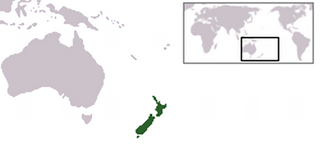 W
WCicadas of New Zealand consist of Cicadidae recorded from the islands of New Zealand. The morphological taxonomy of cicadas present in New Zealand is regarded as being in its infancy. As a result, this list is likely to be subject to change.
 W
WAmphipsalta, commonly known as clapping cicadas, is a genus of cicada in the family Cicadidae. This genus is endemic to New Zealand.
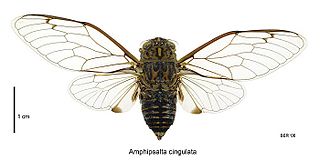 W
WAmphipsalta cingulata, the clapping cicada, is a species of cicada that is endemic to New Zealand.
 W
WAmphipsalta strepitans, the chirping cicada, is a species of cicada that is endemic to New Zealand. This species was first described by George Willis Kirkaldy in 1909.
 W
WThe chorus cicada, Amphipsalta zelandica, is the most common species of cicada in New Zealand, where it is endemic and found in most areas. They typically live in forests and areas with open bush, where their left-over nymph skins can be seen on tree trunks and branches during the summer months. The males produce their cicada sound in unison, which can reach deafening proportions at the height of their population around February. Groups of cicada can suddenly transition from the typical cicada sound to synchronised clicks, using their wings to clap against the surface they are sitting on.
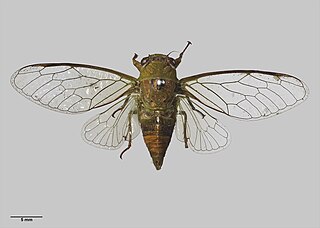 W
WKikihia is a genus of cicada in the family Cicadidae. Most species contained in the genus are endemic to New Zealand, with a single Australian species found on Norfolk Island. The genus was established in 1972 by John S. Dugdale with eleven species formerly classed within the genus Cicadetta.
 W
WKikihia angusta, the tussock cicada, is a species of cicada that is endemic to New Zealand. This species was first described by Francis Walker in 1850.
 W
WKikihia cauta, the greater bronze cicada, is a species of cicada that is endemic to New Zealand. This species was first described by J. G. Myers in 1921.
 W
WKikihia cutora, the snoring cicada, is a species of cicada that is endemic to New Zealand. This species was first described by Francis Walker in 1850.
 W
WKikihia dugdalei, commonly known as Dugdale's cicada, is a species of cicada that is endemic to New Zealand. This species was first described by Charles Fleming in 1984. It was named in honour of John S. Dugdale.
 W
WKikihia horologium, the clock cicada, is a species of cicada that is endemic to New Zealand. This species was first described by Charles Fleming in 1984.
 W
WKikihia laneorum, commonly known as Lane's cicada, is a species of cicada that is endemic to New Zealand. This species was first described by Charles Fleming in 1984. It is named in honour of John and David Lane who discovered this species.
 W
WKikihia longula, commonly known as the Chatham Island cicada, is a species of cicada that is endemic to New Zealand. This species was first described by George Hudson in 1950.
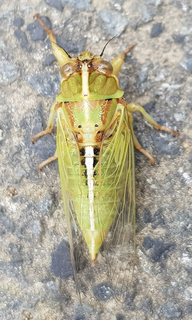 W
WKikihia muta, commonly known as the variable cicada, is a species of cicada that is endemic to New Zealand. This species was first described by Johan Christian Fabricius in 1775.
 W
WKikihia ochrina is a species of insect endemic to New Zealand. This species has a three-year life cycle and adults are bright green in colour and are most commonly seen in the month of April in the North Island.
 W
WKikihia paxillulae, commonly known as Peg's cicada, is a species of cicada that is endemic to New Zealand. This species was first described by Charles Fleming in 1984.
 W
WKikihia rosea, commonly known as the pink or Murihiku cicada, is a species of insect that is endemic to New Zealand. This species was first described by Francis Walker in 1850.
 W
WKikihia scutellaris, commonly known as lesser bronze cicada, is a species of cicada that is endemic to New Zealand. This species was first described by Francis Walker in 1850.
 W
WKikihia subalpina, commonly known as the subalpine green cicada, is a species of cicada that is endemic to New Zealand. This species was first described by George Hudson in 1891.
 W
WMaoricicada, commonly known as black cicadas or mountain black cicadas, is a genus of cicada in the family Cicadidae. This genus is endemic to New Zealand.
 W
WMaoricicada alticola, also known as the high alpine cicada, is a species of cicada that is endemic to New Zealand. This species was first described by John S. Dugdale and Charles Fleming in 1978.
 W
WMaoricicada campbelli, also known as the Campbell's cicada, is a species of cicada that is endemic to New Zealand. This species was first described by John Golding Myers in 1923 under the name Melapsalta campbelli. It was named in honour of James Wishart Campbell, who collected the first specimens of this species.
 W
WMaoricicada cassiope, also known as the screaming cicada, is a species of insect that is endemic to New Zealand. This species was first described by George Hudson in 1891.
 W
WMaoricicada clamitans, also known as the yodelling cicada, is a species of insect that is endemic to New Zealand. This species was first described by John S. Dugdale and Charles Fleming in 1978.
 W
WMaoricicada hamiltoni, also known as the Hamilton's cicada, is a species of insect that is endemic to New Zealand. This species was first described by John Golding Myers in 1926. This species is named in honour of Harold Hamilton.
 W
WMaoricicada iolanthe, also known as the Iolanthe cicada, is a species of insect that is endemic to New Zealand. This species was first described by George Vernon Hudson in 1891.
 W
WMaoricicada lindsayi, also known as the Lindsay's cicada, is a species of insect that is endemic to New Zealand. This species was first described by John Golding Myers in 1923. Myers named the species in honour of Charles Lindsay who collected the holotype specimen.
 W
WMaoricicada mangu is a species of cicada that is endemic to New Zealand. This species was first described by Francis Buchanan White in 1879.
 W
WMaoricicada myersi, also known as Myers' cicada, is a species of insect that is endemic to New Zealand. This species was first described by Charles Fleming in 1971.
 W
WMaoricicada nigra is a species of cicada that is endemic to New Zealand. This species was first described by John Golding Myers in 1921.
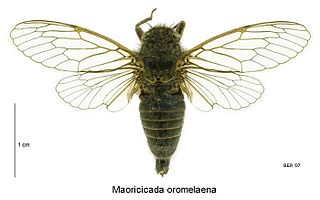 W
WMaoricicada oromelaena, also known as the greater alpine black cicada, is a species of insect that is endemic to New Zealand. This species was first described by John Golding Myers in 1926.
 W
WMaoricicada otagoensis is a species of cicada that is endemic to New Zealand. This species was first described by John S. Dugdale and Charles Fleming in 1978.
 W
WMaoricicada phaeoptera, also known as the southern dusky cicada, is a species of insect that is endemic to New Zealand. This species was first described by John S. Dugdale and Charles Fleming in 1978.
 W
WMaoricicada tenuis, also known as the northern dusky cicada, is a species of insect that is endemic to New Zealand. This species was first described by John S. Dugdale and Charles Fleming in 1978.
 W
WNotopsalta sericea, also known as the clay bank cicada, is a species of insect that is endemic to New Zealand. This species was first described by Francis Walker in 1850.
 W
WRhodopsalta is a genus of cicada in the family Cicadidae. It is endemic to New Zealand.
 W
WRhodopsalta cruentata, also known as the blood redtail cicada, is a species of insect that is endemic to New Zealand. This species was first described in 1775 by Johann Christian Fabricius and named Tettigonia cruentata.
 W
WRhodopsalta leptomera, also known as the sand dune redtail cicada, is a species of insect that is endemic to New Zealand. This species was first described in 1921 by J. G. Myers and named Melampsalta leptomera.
 W
WRhodopsalta microdora, also known as the little redtail cicada, is a species of insect that is endemic to New Zealand. This species was first described in 1936 by George Vernon Hudson and named Melampsalta microdora.